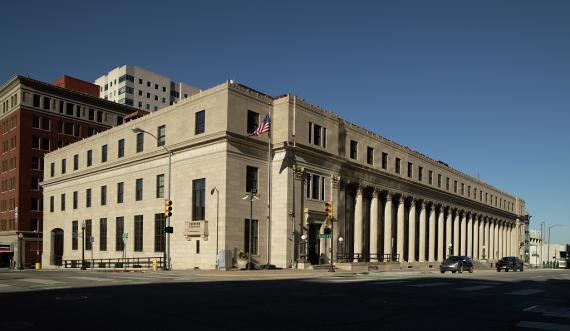Location: 224 S Boulder Ave, Tulsa, OK 74103
The emergence of Tulsa as one of the foremost cities of Oklahoma is reflected by the federal government’s decision to build and enlarge the U.S. Post Office and Courthouse there during WWI and the Great Depression. It is significant both as Tulsa’s first permanent post office and one of Tulsa’s few remaining neoclassical buildings. The building is also a good example of period detailing and craftsmanship.
In 1897 the first post office was established in Tulsa marking the first official designation of the name “Tulsa” for the settlement, previously referred to as “Tusley Town.” Since its establishment, the post office was located in many different buildings in the town of Tulsa. By 1908, a year after Oklahoma became a state, the Tulsa postal service was expanding and free mail delivery service was introduced to the city. By 1913, however, the post office was restricted in working space and direly needed larger headquarters. Tulsa’s rapid growth, mainly attributed to rich strikes in the nearby oil fields, prevented the overworked and cramped postal facility from providing the best service. In February 1913, Tulsa was promised a $350,000 federal building after Senator Robert L. Owen helped to override a public buildings committee recommendation of merely a $58,000 appropriation. Later the larger sum was approved.
Ground breaking for the post office at Third Street and Boulder Avenue occurred in February 1915 and the building was ready for occupancy two and on-half years later. After 38 years of rented space, the post office moved into its own building on July 13, 1917. The original structure was modified in 1930 by the addition of the third floor and the expansion of the north half of the building that tripled its size. In the mid-1960s, the federal government announced plans to construct a new $12 million post office and federal building. As a result, the post office was remodeled into district offices for the U.S. Army Corps of Engineers and a small office for the government’s property management agency, the General Services Administration was also planned. Although there have been some significant changes to the original building, the entire building exterior and nearly all of the finishes and details of the remaining public areas have survived in fine condition.
The building has been nominated to the National Register of Historic Places as one of Tulsa’s important cultural resources worthy of preservation and significant to the community and state.
Building Facts
- Architect: James A. Wetmore
- Construction Dates: 1915-1917
- GSA Building Number: OK0063ZZ
- Landmark Status: Listed in the National Register of Historic Places

 U.S. General Services Administration
U.S. General Services Administration
